Benefits of Playground Equipment
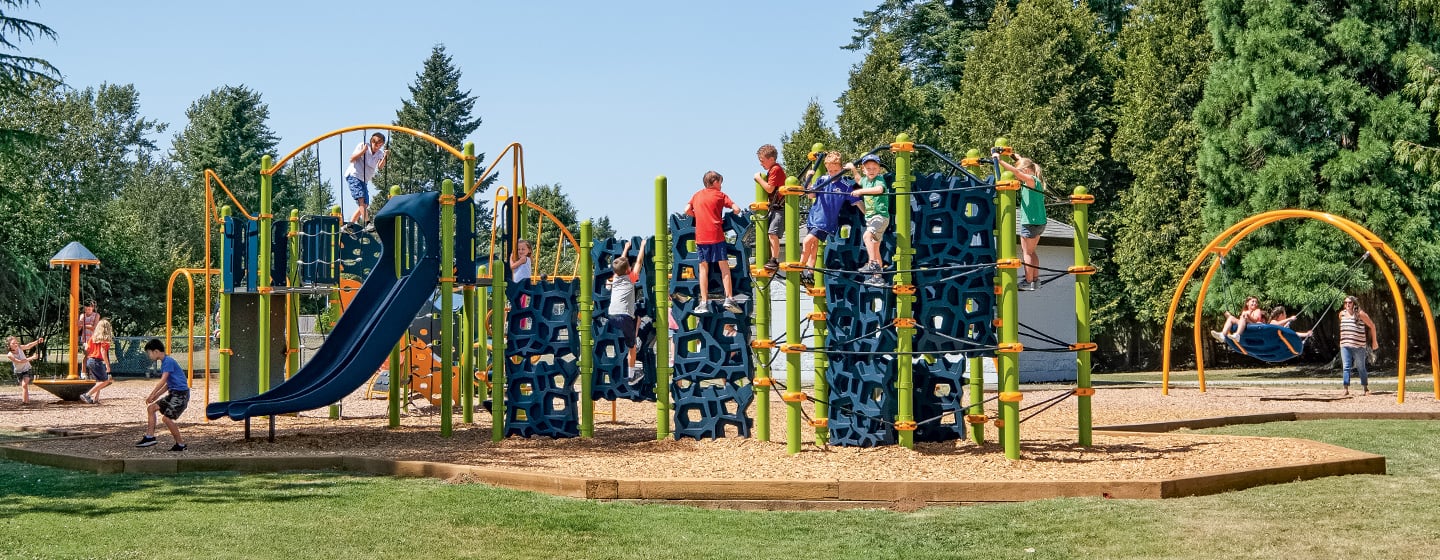
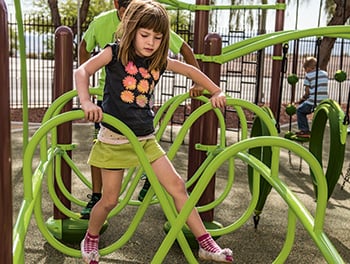 A playground is more than swings, slides and a means to entertain children. The type of play that happens on a playground represents one of the more important parts of a child’s development. Playgrounds are an essential element to the health and development of the mind and body.
A playground is more than swings, slides and a means to entertain children. The type of play that happens on a playground represents one of the more important parts of a child’s development. Playgrounds are an essential element to the health and development of the mind and body.
Playgrounds provide opportunities for children to practice a range of social, emotional, physical and mental skills. By understanding the benefits of adding stimulating and challenging playground equipment to your playground, you can increase the value of play.
Stimulate Development through Playground Equipment
"Through play, all children discover their world and how to be successful in it. The more they play, the more they develop skills necessary to engage, change and impact the world around them." Occupational Therapist and Inclusive Play Expert
A well-designed playground entices children to play and teaches key developmental skills. Playground activities like swinging, climbing and sliding may appear to be "just fun" on the outside, but initiate important body systems to develop and function properly.
The movements children perform on a playground build both gross and fine motor skills, along with core strength. Playground play also enhances the vestibular system — the sensory system that controls balance and coordination — and develops better body awareness.
Developmental Benefits of Playground Equipment
 Sensory Play
Sensory Play
Self-led exploration on sensory play panels help children to further develop their senses. Our high-touch panels provide multiple ways to grow cognitive, tactile, sensory/motor, emotional/social and language skills, and invite children to play with each other and use their imaginations.
Music
Children can explore the power or rhythm, experience subtle shifts in tone, and discover the many ways individual sounds can be creatively combined through our collection of chimes, metallophones and drums.
Sounds and Lights
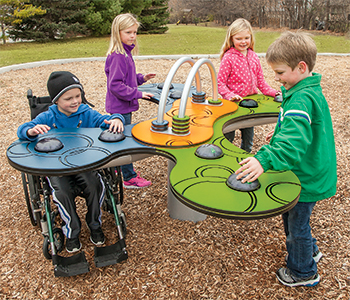 Pulse® interactive games encourage physical movement and challenge hand/eye coordination as well as spatial awareness. With options for head-to-head games or individual creative play, Pulse is exciting, entertaining and rewarding.
Pulse® interactive games encourage physical movement and challenge hand/eye coordination as well as spatial awareness. With options for head-to-head games or individual creative play, Pulse is exciting, entertaining and rewarding.
Tactile
A variety of tactile inputs helps children organize sensory information from the world around them. And because they're fun, tactile play elements lead to opportunities for more cooperative play.
Swinging
The back-and-forth movement of swinging provides a child's nervous system with a wealth of visual, vestibular, and proprioceptive stimulation as they learn how their bodies move in space and how much effort it takes to increase or decrease their speed.
Spinning
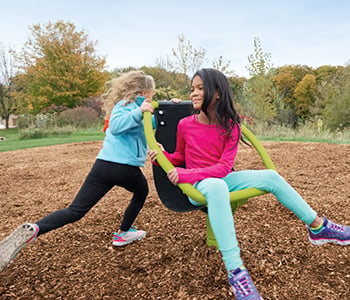 Multi-dimensional movements like spinning and rotating supply children's brains with valuable, complex vestibular information. It connects input from head and body position in space, helping children maintain proper body posture and balance while they play. Our spinners offer optimal opportunities for interchangeable roles and group interaction.
Multi-dimensional movements like spinning and rotating supply children's brains with valuable, complex vestibular information. It connects input from head and body position in space, helping children maintain proper body posture and balance while they play. Our spinners offer optimal opportunities for interchangeable roles and group interaction.
Sliding
Sliding integrates multiple senses, including vestibular, tactile and proprioception. Horizontal rolling (Roller Table™) lets children slide back and forth on all sides of their bodies, which allows for proprioceptive and tactile stimulation and deep pressure, and challenges upper body strength.
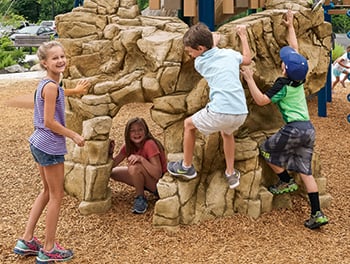 Social/Imaginative
Social/Imaginative
Whether it's a group playing together or one or a few children finding spaces for a quieter adventure, our playground products provide opportunities for all levels of social interaction.
Playground Elements that Stimulate Play Benefits
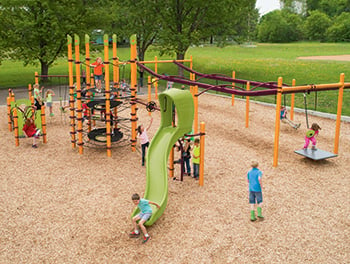 A playground provides the environment needed for children to engage in elements that develop key cognitive, social and physical skills. How children play, or their patterns of play, reinforce the importance of having a mixture of playground equipment that encourages an assortment of play behaviors.
A playground provides the environment needed for children to engage in elements that develop key cognitive, social and physical skills. How children play, or their patterns of play, reinforce the importance of having a mixture of playground equipment that encourages an assortment of play behaviors.
In our whitepaper, Shaped by Play: How Play Types Impact Development, we discuss the findings of an observational study by the University of Minnesota Institute of Child Development that looked at how play spaces shape a child's development. The study suggests that different playground components facilitate different patterns of play and therefore reinforce different developmental skills. In the study, some components—like the overhead ladders and more complex rope climbers—seemed to attract older children and facilitate independent gross motor play. Sometimes children engaged in group games (e.g., tag) or simply talked to one another as they played (e.g., while swinging side-by-side). Other times, they participated in collaborative activities like pushing one another on the swings or working together to spin on the OmniSpin® Spinner.
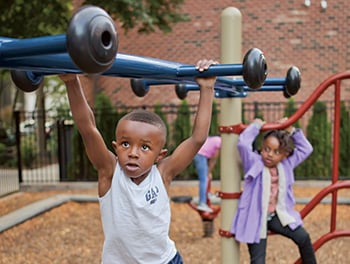 Play involving gross motor skills like custom climbers, rope climbers, overhead ladders, rock areas and slides occupied nearly half of kids' playground time. These are active play elements and in contrast to components that are designed to encourage sensory exploration (e.g., the Smart Play® Motion play structure) or that allow children to sit while someone else operates the equipment (e.g., the swings or We-saw™). When children engage in activities that build and develop gross motor skills they are building upper-body, lower-body and core strength, it can also increase heart rate and improve cardiovascular health, agility, balance, and hand-eye coordination.
Play involving gross motor skills like custom climbers, rope climbers, overhead ladders, rock areas and slides occupied nearly half of kids' playground time. These are active play elements and in contrast to components that are designed to encourage sensory exploration (e.g., the Smart Play® Motion play structure) or that allow children to sit while someone else operates the equipment (e.g., the swings or We-saw™). When children engage in activities that build and develop gross motor skills they are building upper-body, lower-body and core strength, it can also increase heart rate and improve cardiovascular health, agility, balance, and hand-eye coordination.
Additional Skills Supported by Play Patterns on a Playground
Creativity is encouraged when children use playground equipment as the basis for imaginative games. A child's imagination turns a climbing tower into a spaceship or boat. Their play morphs and adjusts to their skill level and they create an obstacle course or climb on the outside of a Netplex® playstructure instead of the inside to increase difficulty.
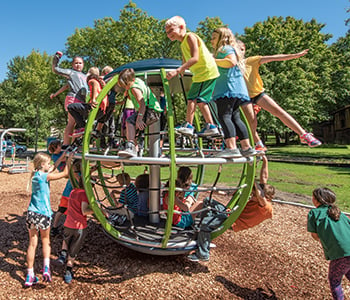 Collaboration and cooperation can be encouraged by specific components that require children to work together. Slides or our ZipKrooz® zipline structures require turn-taking and communication. Our Global Motion® and seesaws also encourage collaboration because children can operate them as a team, some ride and some push. Sound and movement can even be utilized with Pulse® multisensory playground games to encourage collaboration in an interactive way.
Collaboration and cooperation can be encouraged by specific components that require children to work together. Slides or our ZipKrooz® zipline structures require turn-taking and communication. Our Global Motion® and seesaws also encourage collaboration because children can operate them as a team, some ride and some push. Sound and movement can even be utilized with Pulse® multisensory playground games to encourage collaboration in an interactive way.
Problem-solving skills can be enhanced with various climbing elements. Children work to figure out how to physically navigate a piece of equipment, especially one that is new to them.
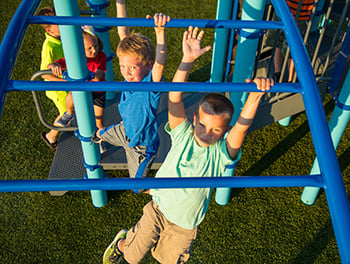 Persistence can be encouraged when a child keeps trying and doesn't give up when experiencing a playground activity that is difficult such as crossing the monkey bars. Once a goal is achieved or a skill mastered, the child feels a huge sense of accomplishment and increased self-esteem from working hard to reach a goal.
Persistence can be encouraged when a child keeps trying and doesn't give up when experiencing a playground activity that is difficult such as crossing the monkey bars. Once a goal is achieved or a skill mastered, the child feels a huge sense of accomplishment and increased self-esteem from working hard to reach a goal.
Playgrounds also offer the opportunity for children of different ages to learn from and help one another. Children will often copy or learn from older children or older children may help younger children—boosting them up while they were climbing, helping them on and off the equipment, encouraging them not to be scared, and offering to help them down from the top of a tall structure. These mixed-age social interactions are an important part of children's social experiences on the playground.
The play patterns of children illustrate the importance of having a variety of playground equipment that encourages an assortment of play behaviors. Check out our many options of age-appropriate and challenging equipment or contact a Landscape Structures consultant .